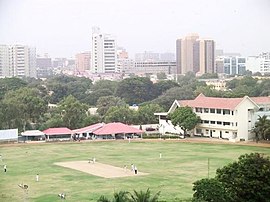센타우루스자리 프시
Psi Centauri| 관측 데이터 Epoch J2000.0 이쿼녹스 J2000.0 | |
|---|---|
| 별자리 | 센타우루스 |
| 우측 상승 | 14h 20m 33.43s[1] |
| 탈위임 | −37° 53′ 07.1″[1] |
| 겉보기 크기 (V) | +4.05[2] |
| 특성. | |
| 스펙트럼형 | A0 IV[3]([4]B9 및 A2) |
| U-B색지수 | −0.11[3] |
| B-V색지수 | −0.03[3] |
| 변수형 | 에클립싱[4] |
| 아스트로메트리 | |
| 방사 속도 (Rv) | 1.8±0.9km[5]/s |
| 고유 운동 (μ) | RA:−63.69±0.18[1]mas/yr Dec.:−10.65±0.15[1]mas/yr |
| 시차 (π) | 12.60 ± 0.20[1] mas |
| 거리 | 259 ± 4 리 (79 ± 1 pc) |
| 절대치수 (MV) | −0.35±0.14[6] |
| 궤도[4] | |
| 기간 (P) | 38.81252±0.00029 d |
| 편심성 (e) | 0.55408±0.00024 |
| 기울기 (i) | 88.955±0.012° |
| 페리아스트론의 인수 (ω) (2차) | 20.095±0.098° |
| 반암도 (K1) (iii) | 49.01±0.11km[7]/s |
| 반암도 (K2) (2차) | 79.92±0.15km[7]/s |
| 세부 사항 | |
| ψ Cen A | |
| 미사 | 3.114[8] M☉ |
| 반지름 | 3.634[8] R☉ |
| 루미도 | 141[8] L☉ |
| 표면 중력 (log g) | 3.811±0.003[7] cgs |
| 온도 | 10,450[8] K |
| 회전 | 1.49±0.26d[4] |
| 회전 속도 (v sin i) | 123.7km[7]/s |
| 나이 | 269[6] 마이어 |
| ψ Cen B | |
| 미사 | 1.909[8] M☉ |
| 반지름 | 1.811[8] R☉ |
| 루미도 | 18[8] L☉ |
| 표면 중력 (log g) | 4.206±0.007[7] cgs |
| 온도 | 8800K[8] |
| 회전 속도 (v sin i) | 초속 126.9km[7] |
| 기타 지정 | |
| 데이터베이스 참조 | |
| 심바드 | 자료 |
aur 센타우루스자리로부터 라틴어로 표기된 Psi Centauri는 센타우루스 남쪽 별자리에 있는 이진 항성계통이다[10].기준 외관상 시각적 크기가 +4.05일 때 육안으로 볼 수 있다.[2]이 시스템까지의 거리는 시차 기준으로 약 259광년이다.[1]방사 속도는 제약을 잘 받지 않지만 +2 km/s의 속도로 태양으로부터 서서히 표류하고 있는 것으로 보인다.[5]
이것은 2차 일식이 총계인 분리된 2차 일식이다.[4]이 쌍은 38.81일의 기간과 0.55의 편심률로 서로 궤도를 돌고 있다.[10]궤도당 두 번의 일식 동안 시스템의 밝기는 0.28과 0.16의 크기만큼 떨어진다.[4]이 시스템은 60μm의 파장에서 적외선 과열을 표시하는데, 이는 64AU 거리에서 궤도를 선회하는 120K의 원위선 이물질 원반이 존재함을 나타낸다.[11]
이 쌍은 A0 IV의 복합 항성 분류를 가지고 있으며,[3] 백후 A형 소거제와 일치한다.[2]그 두 요소는 서로 다른 진화 단계에 있는 것으로 보인다.[4]둘 다 회전 속도가 120km/s 이상으로 예상되며 회전 속도가 높다.[7]1차 경선은 태양의 3.6배, 2차 경선은 1.8배이다.[8]경선에서는 하루 1.996회, 5.127회 주기로 맥동행동의 증거를 보여주었는데,[4] 이는 서서히 맥동하는 B별임을 시사한다.[7]그러나 이는 2017년 현재 확인되지 않은 상태로 남아 있으며,[12] 이번 발견은 오히려 기계의 오류의 결과일 수 있다.[7]
참조
- ^ a b c d e f van Leeuwen, F. (2007), "Validation of the new Hipparcos reduction", Astronomy and Astrophysics, 474 (2): 653–664, arXiv:0708.1752, Bibcode:2007A&A...474..653V, doi:10.1051/0004-6361:20078357, S2CID 18759600. Vizier 카탈로그 항목
- ^ a b c Johnson, H. L.; et al. (1966), "UBVRIJKL photometry of the bright stars", Communications of the Lunar and Planetary Laboratory, 4 (99): 99, Bibcode:1966CoLPL...4...99J.
- ^ a b c d Buscombe, W. (1962), "Spectral classification of Southern fundamental stars", Mount Stromlo Observatory Mimeogram, 4: 1, Bibcode:1962MtSOM...4....1B.
- ^ a b c d e f g h Bruntt, H.; et al. (September 2006), "Eclipsing binaries observed with the WIRE satellite. I. Discovery and photometric analysis of the new bright A0 IV eclipsing binary ψ Centauri", Astronomy and Astrophysics, 456 (2): 651–658, arXiv:astro-ph/0606551, Bibcode:2006A&A...456..651B, doi:10.1051/0004-6361:20065628, S2CID 16701277.
- ^ a b Gontcharov, G. A. (November 2006), "Pulkovo Compilation of Radial Velocities for 35495 Hipparcos stars in a common system", Astronomy Letters, 32 (11): 759–771, arXiv:1606.08053, Bibcode:2006AstL...32..759G, doi:10.1134/S1063773706110065, S2CID 119231169.
- ^ a b Gerbaldi, M.; et al. (June 1999), "Search for reference A0 dwarf stars: Masses and luminosities revisited with HIPPARCOS parallaxes", Astronomy and Astrophysics Supplement, 137 (2): 273–292, Bibcode:1999A&AS..137..273G, doi:10.1051/aas:1999248.
- ^ a b c d e f g h i Mantegazza, L.; et al. (March 2010), "Spectroscopic search for g-mode pulsations in ψ Centauri", Astronomy and Astrophysics, 512: 5, Bibcode:2010A&A...512A..42M, doi:10.1051/0004-6361/200913013, A42.
- ^ a b c d e f g h i Eker, Z.; et al. (April 2015), "Main-Sequence Effective Temperatures from a Revised Mass-Luminosity Relation Based on Accurate Properties", The Astronomical Journal, 149 (4): 16, arXiv:1501.06585, Bibcode:2015AJ....149..131E, doi:10.1088/0004-6256/149/4/131, S2CID 118740259, 131.
- ^ "psi Cen". SIMBAD. Centre de données astronomiques de Strasbourg. Retrieved 2017-06-30.
- ^ a b Eggleton, P. P.; Tokovinin, A. A. (September 2008), "A catalogue of multiplicity among bright stellar systems", Monthly Notices of the Royal Astronomical Society, 389 (2): 869–879, arXiv:0806.2878, Bibcode:2008MNRAS.389..869E, doi:10.1111/j.1365-2966.2008.13596.x, S2CID 14878976.
- ^ Rhee, Joseph H.; et al. (May 2007), "Characterization of Dusty Debris Disks: The IRAS and Hipparcos Catalogs", The Astrophysical Journal, 660 (2): 1556–1571, arXiv:astro-ph/0609555, Bibcode:2007ApJ...660.1556R, doi:10.1086/509912, S2CID 11879505.
- ^ Liakos, Alexios; Niarchos, Panagiotis (February 2017), "Catalogue and properties of δ Scuti stars in binaries", Monthly Notices of the Royal Astronomical Society, 465 (1): 1181–1200, arXiv:1611.00200, Bibcode:2017MNRAS.465.1181L, doi:10.1093/mnras/stw2756.



